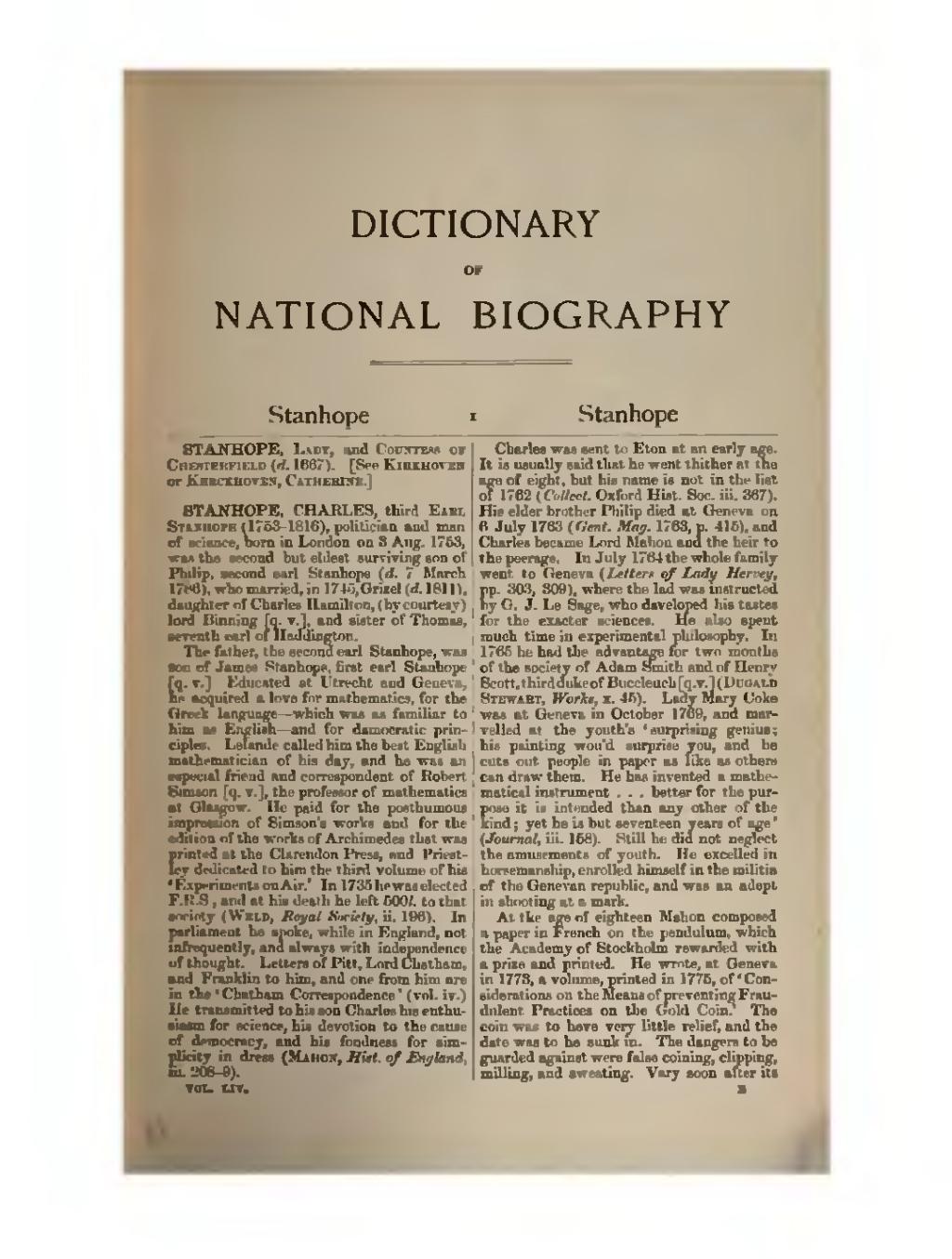DICTIONARY
OF
NATIONAL BIOGRAPHY
STANHOPE, Lady, and Countess of Chesterfield (d. 1667). [See Kirkhoven or Kerckhoven, Catherine.]
STANHOPE, CHARLES, third Earl Stanhope (1753–1816), politician and man of science, born in London on 3 Aug. 1753, was the second but eldest surviving son of Philip, second earl Stanhope (d. 7 March 1786), who married, in 1745, Grizel (d. 1811), daughter of Charles Hamilton, (by courtesy) lord Binning [q. v.], and sister of Thomas, seventh earl of Haddington. The father, the second earl Stanhope, was son of James Stanhope, first earl Stanhope [q. v.] Educated at Utrecht and Geneva, he acquired a love for mathematics, for the Greek language—which was as familiar to him as English—and for democratic principles. Lalande called him the best English mathematician of his day, and he was an especial friend and correspondent of Robert Simson [q. v.], the professor of mathematics at Glasgow. He paid for the posthumous impression of Simson's works and for the edition of the works of Archimedes that was printed at the Clarendon Press, and Priestley dedicated to him the third volume of his ' Experiments on Air.' In 1735 he was elected F.R.S., and at his death he left 500 l. to that society (Weld, Royal Society, ii. 196). In parliament he spoke, while in England, not infrequently, and always with independence of thought. Letters of Pitt, Lord Chatham, and Franklin to him, and one from him are in the 'Chatham Correspondence' (vol. iv.) He transmitted to his son Charles his enthusiasm for science, his devotion to the cause of democracy, and his fondness for simplicity in dress (Mahon, Hist. of England, iii. 208-9).
Charles was sent to Eton at an early age. It is usually said that he went thither at the age of eight, but his name is not in the list of 1762 (Collect. Oxford Hist. Soc. iii. 367). His elder brother Philip died at Geneva on 6 July 1763 (Gent. Mag. 1763, p. 415), and Charles became Lord Mahon and the heir to the peerage. In July 1764 the whole family went to Geneva (Letters of Lady Hervey, pp. 303, 309), where the lad was instructed by G. J. Le Sage, who developed his tastes for the exacter sciences. He also spent much time in experimental philosophy. In 1765 he had the advantage for two months of the society of Adam Smith and of Henry Scott, third duke of Buccleuch [q. v.] (Dugald Stewart, Works, x. 45). Lady Mary Coke was at Geneva in October 1769, and marvelled at the youth's 'surprising genius; his painting wou'd surprise you, and he cuts out people in paper as like as others can draw them. He has invented a mathematical instrument … better for the purpose it is intended than any other of the kind; yet he is but seventeen years of age' (Journal, iii. 158). Still he did not neglect the amusements of youth. He excelled in horsemanship, enrolled himself in the militia of the Genevan republic, and was an adept in shooting at a mark.
At the age of eighteen Mahon composed a paper in French on the pendulum, which the Academy of Stockholm rewarded with a prize and printed. He wrote, at Geneva in 1773, a volume, printed in 1775, of 'Considerations on the Means of preventing Fraudulent Practices on the Gold Coin.' The coin was to have very little relief, and the date was to be sunk in. The dangers to be guarded against were false coining, clipping, milling, and sweating. Very soon after its
